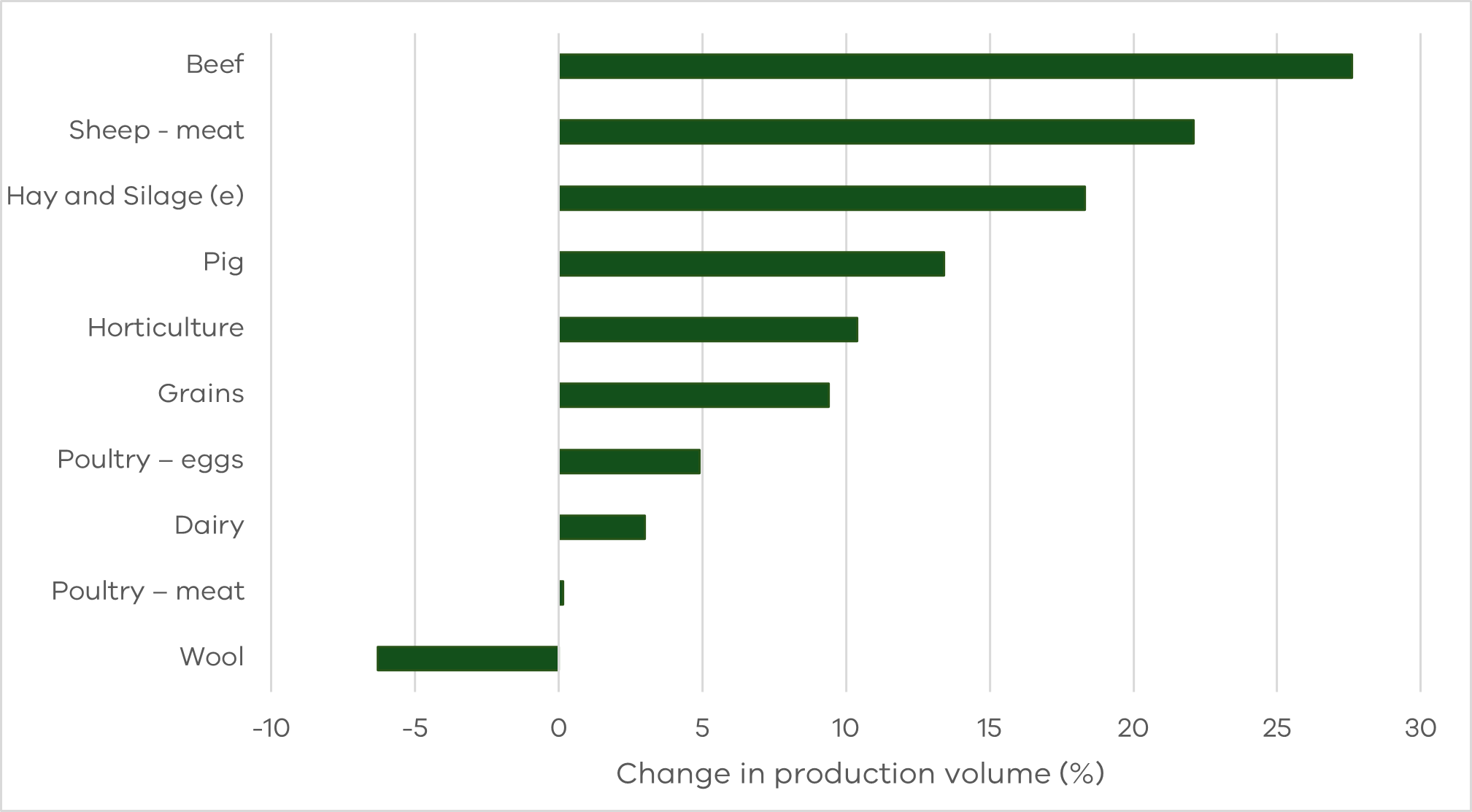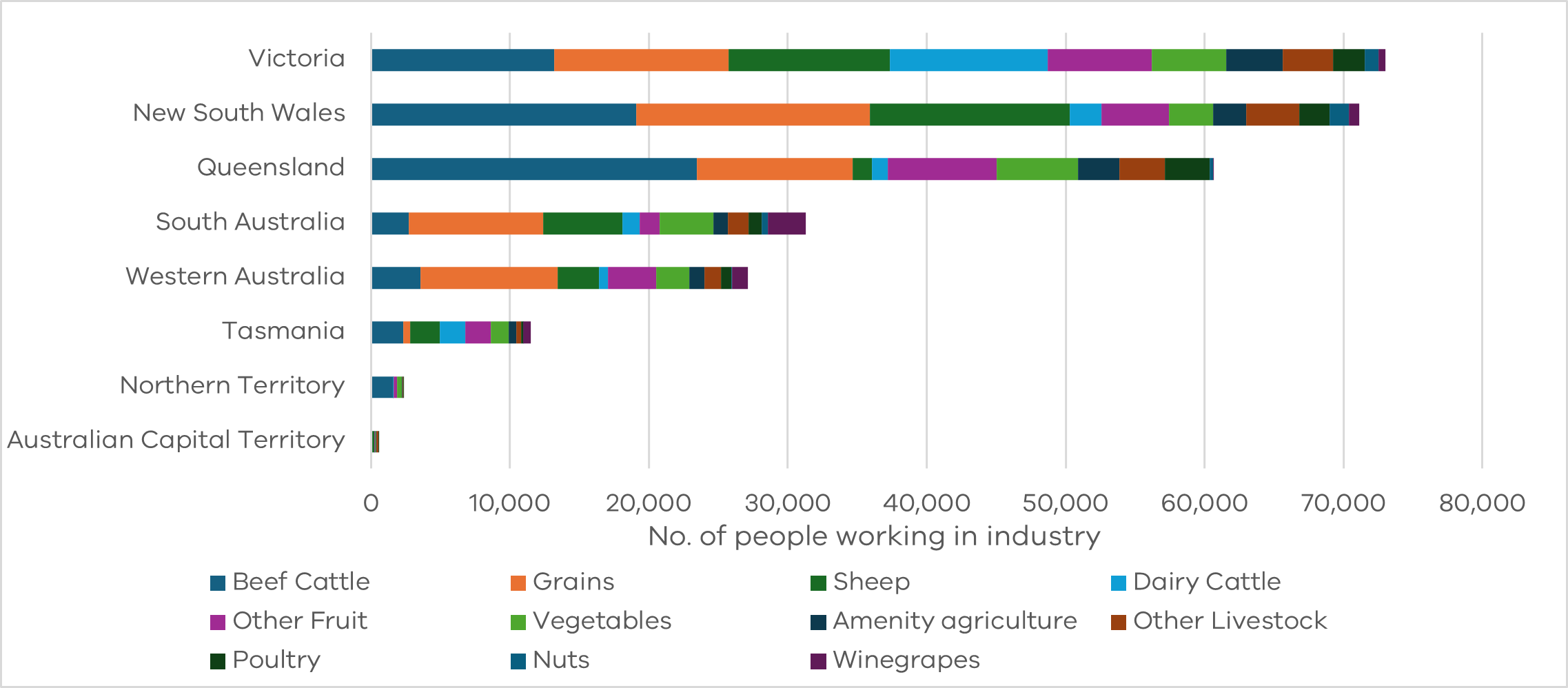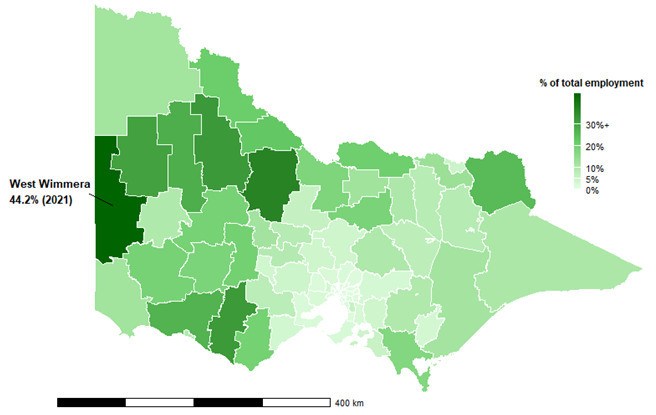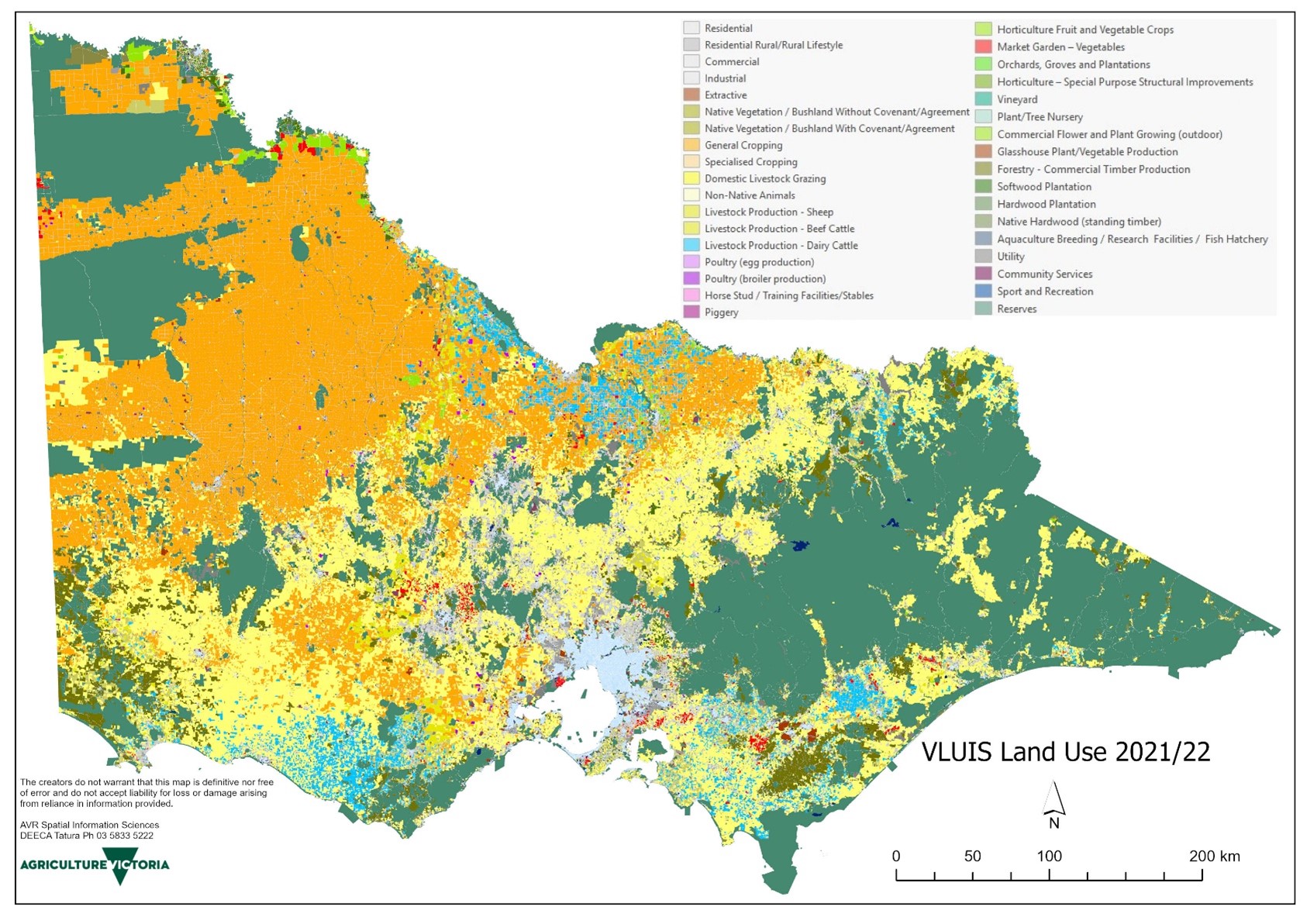Victoria’s agriculture and food industries
Overview of Victoria’s agriculture industry
Victoria is Australia’s leading producer, processor and exporter of agriculture, food and fibre products. Victoria’s gross value of agricultural production (GVAP) has reached a record high of $20 billion, with food and fibre exports from Victoria also at a record high of $20.1 billion (2023–24).
Victoria is home to Australia’s largest agriculture and food processing workforce – providing employment to 150,700 people across these two industries (around 73,000 in agriculture and 77,700 in food and beverage processing [2022–23]).
Victoria’s agriculture sector supports 21,300 farm businesses in Victoria and manages around 11 million hectares, or half of the state’s land (2021–22).
View a map of Victoria’s regions by gross value of agricultural production.
Production volumes
In 2023–24, production increased for all farm products except wool, compared to the year before. Beef had the biggest jump, rising by 27.6% (or over 101,000 extra tonnes).
Figure 1: Change in production volume from FY2023 to FY2024

Source: ABS 2025 (livestock, horticulture, broadacre crops); Australian Wool Innovation (2025); Dairy Australia (2025); Eggs Australia (2025).
Note: e indicates estimate.
Table 1: Production volume by commodity
Commodity | Unit | 2022–23 | 2023–24 | Unit change from 2022–23 | % change from 2022–23 |
|---|---|---|---|---|---|
Dairy | L (million) | 5,141 | 5,296 | 155 | 3.0 |
Beef | tonnes | 366,698 | 467,934 | 101,236 | 27.6 |
Sheep – meat | tonnes | 349,159 | 426,346 | 77,187 | 22.1 |
Wool | MKg greasy | 70 | 66 | −4 | −6.3 |
Grains | tonnes | 9,779,279 | 10,699,132 | 919,853 | 9.4 |
Hay and silage (e) | tonnes | 3,390,000 | 4,010,105 | 620,105 | 18.3 |
Horticulture | tonnes | 1,749,508 | 1,931,122 | 181,614 | 10.4 |
Pig | tonnes | 94,346 | 107,014 | 12,668 | 13.4 |
Poultry – meat | tonnes | 273,567 | 273,611 | 44 | 0.0 |
Poultry – eggs | dozen ('000) | 123,698 | 129,741 | 6,043 | 4.9 |
Source: ABS 2025 (livestock, horticulture, broadacre crops); Australian Wool Innovation (2025); Dairy Australia (2025); Eggs Australia (2025).
Note: e indicates estimate.
Victoria’s food and fibre exports
Victoria’s food and fibre exports reached a record high, valued at $20.1 billion in 2023–24 – a 3% increase on the previous year. These results cemented Victoria’s position as Australia's largest food and fibre exporter by value, accounting for 27% of the national total.
By value, Victoria's top 5 food and fibre exports are:
- meat ($5.7 billion)
- grain ($4.9 billion)
- dairy ($2.5 billion)
- animal fibre ($2.1 billion)
- horticulture ($1.5 billion).
Victoria's food and fibre export commodities were traded in 172 countries, with China remaining the most valuable market. Victoria’s top 5 food and fibre export market destinations in 2023-24 accounted for around 47% of Victoria’s total food and fibre exports. Ranked by value, they are:
- China ($4.8 billion)
- United States ($2.1 billion)
- Japan ($1.9 billion)
- New Zealand ($1.0 billion)
- Indonesia ($1.0 billion).
Key highlights of Victoria’s food and fibre exports, including a downloadable summary, data tables and an interactive dashboard, can be accessed on our Export page.
Employment
In 2022–23, there were around 150,700 people employed in Victoria’s agri-food production and processing sectors. This includes 73,000 in agriculture and 77,700 in food and beverage manufacturing.
Victoria has the largest agriculture workforce in Australia with a 26.3% share, with NSW in second place at 25.6%. More than 85% of employment in agriculture production is in regional Victoria.
Figure 2: Agriculture employment by state and territory (2022–23)

Source: Agriculture Victoria RISE model (2025), informed by ABS (2023) Labour Force Survey.
Figure 3: Employment in agriculture and food and beverage processing sectors, as a proportion of total employment by local government area (2021)

Source: ABS Census (2021)
Table 2: Employment in food and fibre production and processing, by regional partnership (2022–23)
| Industry | Barwon | Central Highlands | Gippsland | Goulburn | Great South Coast | Greater Melbourne | Loddon Campaspe | Mallee | Ovens Murray | Wimmera & Southern Mallee | Grand total |
|---|---|---|---|---|---|---|---|---|---|---|---|
Agriculture, forestry and fishing (AFF) total | 3,561 | 5,185 | 11,133 | 9,176 | 10,393 | 12,863 | 7,914 | 10,480 | 5,362 | 5,709 | 81,777 |
Agriculture | 3,063 | 4,668 | 9,876 | 8,404 | 9,347 | 10,683 | 7,359 | 9,296 | 4,885 | 5,446 | 73,026 |
AFF support services | 273 | 453 | 698 | 685 | 763 | 1,718 | 534 | 1,175 | 308 | 261 | 6,868 |
Aquaculture | 30 | – | 11 | 16 | 20 | 60 | – | 2 | 2 | 1 | 141 |
Fishing, hunting and trapping | 83 | – | 114 | 26 | 23 | 108 | – | – | – | – | 355 |
Forestry and logging | 113 | 64 | 434 | 46 | 240 | 294 | 21 | 9 | 167 | – | 1,387 |
Food and fibre processing total | 5,501 | 2,977 | 6,396 | 4,351 | 3,339 | 69,992 | 8,181 | 2,074 | 5,081 | 1,038 | 108,930 |
Food products | 3,119 | 2,134 | 3,597 | 3,630 | 2,854 | 41,587 | 6,732 | 1,144 | 2,492 | 872 | 68,160 |
Beverage products | 429 | 336 | 201 | 357 | 69 | 5,914 | 549 | 655 | 949 | 105 | 9,564 |
Wood products | 1,018 | 344 | 915 | 213 | 316 | 7,212 | 391 | 119 | 1,166 | 25 | 11,719 |
Pulp, paper and converted paper products | 66 | 2 | 1,537 | 129 | 3 | 5,466 | – | 54 | 172 | – | 7,429 |
Textile, leather, clothing and footwear | 869 | 161 | 147 | 22 | 97 | 9,814 | 508 | 103 | 301 | 36 | 12,058 |
All food and fibre production and processing | 9,062 | 8,161 | 17,529 | 13,527 | 13,732 | 82,855 | 16,095 | 12,555 | 10,443 | 6,747 | 190,707 |
Economy-wide total employment | 153,710 | 85,416 | 147,082 | 85,031 | 70,885 | 2,724,091 | 147,805 | 64,271 | 75,495 | 32,273 | 3,586,059 |
Food and fibre production and processing, as % of total employment | 5.9 | 9.6 | 11.9 | 15.9 | 19.4 | 3.0 | 10.9 | 19.5 | 13.8 | 20.9 | 5.3 |
Source: Agriculture Victoria RISE model (2025), based on ABS Labour Force Survey (2022–23).
Table 3: Employment in food and fibre, year-on-year growth and industry proportions
Industry | Employment in 2022–23 | Growth rate 2021–22 to | Average CAGR FY16 to FY21 (%)* | Share of AFF, 2022–23 (%) | Share of food and fibre processing, 2022–23 (%) |
|---|---|---|---|---|---|
Agriculture, forestry and fishing (AFF) total | 81,777 | 0.9 | 1.3 | 100.0 | – |
Agriculture | 73,026 | 1.7 | 1.0 | 89.3 | – |
AFF support services | 6,868 | -2.8 | 5.8 | 8.4 | – |
Aquaculture* | 141 | -32.2 | 1.2 | 0.2 | – |
Fishing, hunting and trapping* | 355 | 27.0 | -3.8 | 0.4 | – |
Forestry and logging | 1,387 | -16.4 | 2.0 | 1.7 | – |
Food and fibre processing total | 108,930 | 42.3 | 1.2 | – | 100.0 |
Food products | 68,160 | 0.3 | 1.9 | – | 62.6 |
Beverage products | 9,564 | 11.4 | 2.5 | – | 8.8 |
Wood products | 11,719 | -6.6 | -1.5 | – | 10.8 |
Pulp, paper and converted paper products | 7,429 | 0.0 | -0.3 | – | 6.8 |
Textile, leather, clothing and footwear | 12,058 | -6.9 | -1.6 | – | 11.1 |
All food and fibre production and processing | 190,707 | 0.1 | 1.2 | – | – |
Source: Agriculture Victoria RISE model (2025), based on ABS Labour Force Survey (2022 and 2023); ABS Census of Population and Housing (2016 and 2021).
* Indicates small sample size: growth rate 2021–22 to 2022–23 may be unreliable.
Farm business numbers
In 2021–22, there were around 21,300 farm businesses in Victoria. The ABS counts a farm as a business if its gross income averages at least $40,000 a year.
Table 4: Number of farm businesses by detailed commodity, VIC, 2020–21
Industry (ANZSIC) | Industry detail (ANZSIC) | Number of farms | As % (detailed)
| As % (broad) |
|---|---|---|---|---|
Dairy | Dairy | 3,397 | 15.7 | 15.7 |
Beef | Specialised (broadacre) | 5,350 | 24.8 | 24.8 |
Feedlots | 11 | 0.1 | ||
Sheep | Specialised | 3,627 | 16.8 | 22.3 |
Sheep with beef cattle* | 1,178 | 5.5 | ||
Broadacre cropping | Grain growing | 2,212 | 10.2 | 22.0 |
Mixed cropping (with sheep and/or beef cattle) | 2,181 | 10.1 | ||
Other broadacre cropping | 360 | 1.7 | ||
Horticulture (edible, fruit and nuts) | Apple and pear growing | 161 | 0.7 | 7.1 |
Berry fruit growing | 91 | 0.4 | ||
Citrus fruit growing | 90 | 0.4 | ||
Kiwifruit growing | 11 | 0.1 | ||
Olive growing | 51 | 0.2 | ||
Stone fruit growing | 172 | 0.8 | ||
Grape growing | 814 | 3.8 | ||
Other fruit and tree nut growing | 137 | 0.6 | ||
Horticulture (edible, vegetables) | Vegetable growing (outdoors) | 561 | 2.6 | 2.9 |
Vegetable growing (under cover) | 47 | 0.2 | ||
Mushroom growing | 17 | 0.1 | ||
Horticulture (amenity) | Floriculture production (outdoors) | 76 | 0.4 | 1.6 |
Floriculture production (under cover) | 68 | 0.3 | ||
Nursery production (outdoors) | 106 | 0.5 | ||
Nursery production (under cover) | 61 | 0.3 | ||
Turf growing | 30 | 0.1 | ||
Other livestock | Pigs | 90 | 0.4 | 3.6 |
Poultry – eggs | 100 | 0.5 | ||
Poultry – meat | 144 | 0.7 | ||
Beekeeping | 57 | 0.3 | ||
Deer | 20 | 0.1 | ||
Horses | 281 | 1.3 | ||
Other livestock | 94 | 0.4 | ||
Total | 21,592 | 100.0 | 100.0 |
Source: ABS (2021) Agriculture Census.
Note: Data on the number of farm businesses that is more recent than 2020–21 is available for dairy and broadacre farming only, via ABARES Farm Data Portal 2025.
Area and land use
The area of land used for agricultural production in Victoria was 10.7 million hectares in 2021–22, or 48% of the state’s total land. This represents 3% of Australia’s total agricultural land area.
Figure 4: Victoria Land Use Information System 2021–22

Source: Agriculture Resources Sciences, Agriculture Victoria Research (2025).
Farm-level economic performance data
For data and information on farm-level economic performance visit Agriculture Victoria's websites for the Dairy Farm Monitor Project and Livestock Farm Monitor Project.